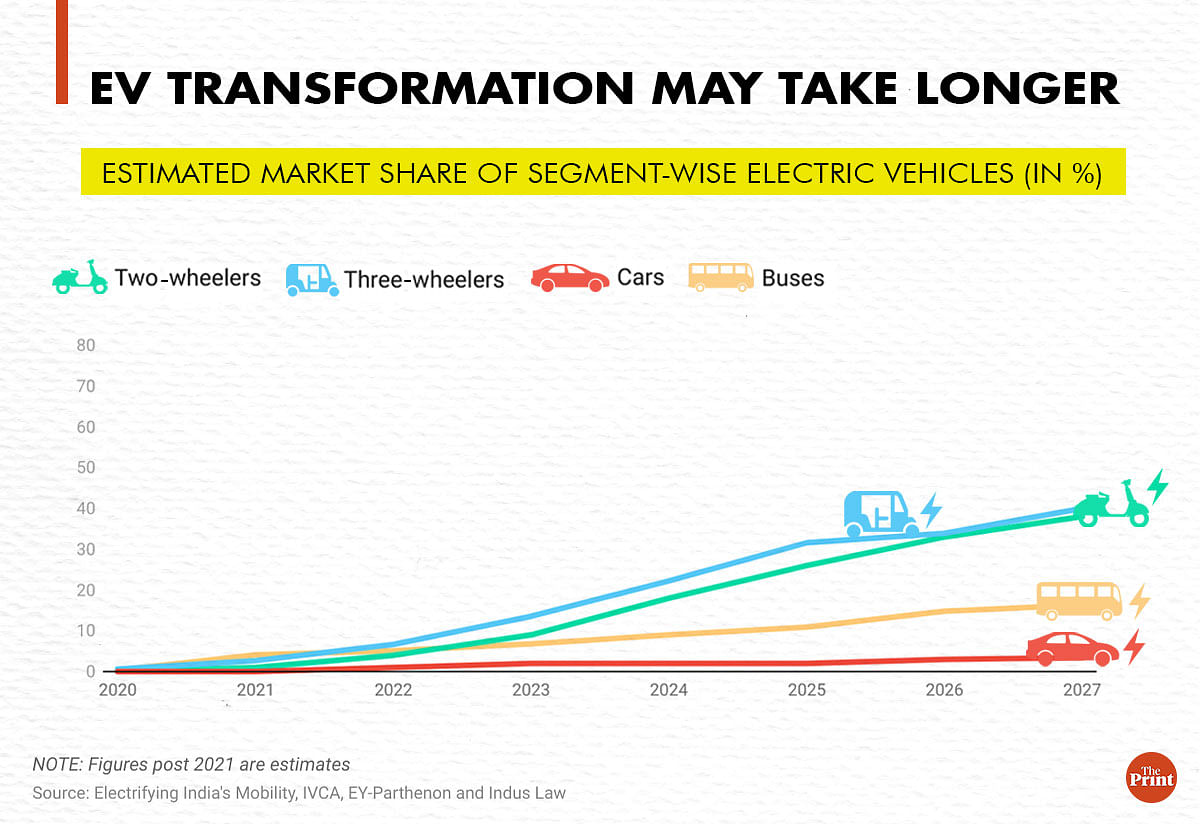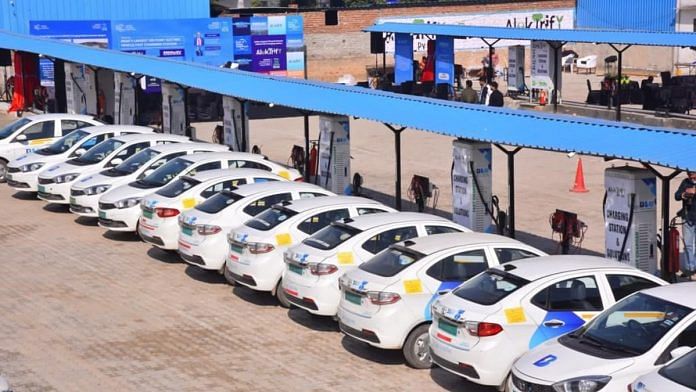New Delhi: Electric vehicles (EVs) have elicited excitement in the Indian automobile industry, but for India to achieve its EV target by 2030, the manufacturers will have to report exponential growth in sales.
Union Minister Nitin Gadkari had said last year that by 2030, the government intends to have EV sales accounting for 30 per cent of private cars, 70 per cent of commercial vehicles, and 80 per cent of two- and three-wheelers. However, according to a report released last month by the Indian Venture and Alternate Capital Association (IVCA) — an organisation working on promoting capital ecosystem — this target is a bit ‘aggressive’.
The IVCA’s observation is based on a combination of factors including less than adequate charging infrastructure, high cost of batteries and low expenditure on research and development.
Its report ‘Electrifying Indian Mobility’ projected that by 2027, EVs may account for less than 4 per cent, 38 per cent and about 40 per cent of India’s cars, two-wheelers and three-wheelers respectively, in terms of market share.
The IVCA prepared the report in collaboration with management consulting firm EY-Parthenon and law firm Indus Law.
Also Read: Your next car should be electric. But do the math first before you decide to plug and play
Why EV craze is subdued
When it comes to EV cars, the IVCA report says low distance range and limited choices are among the main reasons for their limited acceptance.
“There are only a few models available in the market. In addition, these models have range issues and are slow charging. Newer and better models are expected in the coming years,” it states.
High prices, too, is a big factor for the low market penetration of EVs. At present, the most affordable normal sized electric car costs a minimum of Rs 12.49 lakh (average ex-showroom) while a petrol car (the cheapest) costs nearly three times lesser, with prices starting at around Rs 3.8 lakh.
The use of special metals in the battery makes up a major chunk of an EV’s price, which, according to a June NITI Aayog report, if not lowered, can have a significant impact on EV adoption in the country.
The report, titled ‘Forecasting Penetration of Electric Two-Wheelers’, states that even if battery costs come down by 2 per cent annually, hardly 16-17 per cent of two-wheelers on Indian roads will be electric by 2030, and that too if the government keeps providing incentives.
The two-wheeler EVs can form more than 90 per cent of the segment sales only when the battery prices drop by over 8 per cent every year on average along with improvement in power and range, according to the NITI Aayog.
The IVCA report, meanwhile, cites four barriers to growth of the EV market. “Charging infrastructure is the foundation on which the EV market is built and India has not achieved an expeditious pace of establishment and use of charging infrastructure which creates a barrier in both production and sale of EVs,” it says.
While there are only 1,742 charging stations currently in the country, this number is expected to reach 100,000 units by 2027.
India’s inefficient power distribution system adds uncertainty to the EV charging infrastructure, the report adds. “Factors like unsurety in utilisation rates of charging stations, huge operating costs, load on electricity discoms, etc., create a negative environment for operators to establish charging stations and discourage investment when there are not sufficient numbers of EVs in Indian roads for operators to realise the returns on their investments.”
The use of lithium-ion batteries, which require metals and minerals not found abundantly in India and inflate import bills, acts as a second big hurdle. Low expenditure on research and development and usage of coal as a major source of energy to charge EVs are the other hurdles, according to IVCA.
EVs remain an untapped opportunity for the market players and have a large scope for investment, according to Ishpreet Gandhi, founder and managing partner of venture capital firm Stride Ventures.
“Within the start-up ecosystem, we have seen a significant rise in the number of companies in the EV space in the past couple of years. EV has almost become synonymous with start-ups with the majority of the companies in the space being recently established,” the IVCA report quotes Gandhi as saying.
According to him, while investment in EVs has increased, it continues to be “a largely untapped market, presenting a significant opportunity for investors to bridge the funding gap through structures like vehicle financing, capex financing, etc”.
“This presents a huge opportunity for EVs to be driven commercially through electric bikes, rickshaws, buses, cabs, etc,” he adds.
Also Read: EVs ‘aren’t the answer’, Maruti Suzuki bets on hybrid technology, biofuels in clean shift
Overambitious targets?
In the first week of August, the Ministry of Road Transport and Highways informed Parliament that there were 13,92,265 EVs, including 7.93 lakh three-wheelers and 5.45 lakh two-wheelers, in the country.

According to the IVCA report, EVs will report phenomenal growth at least in the two-wheeler segment. From an estimated 5.35 lakh units in 2022, the two-wheeler EV sale is likely to swell to 72 lakh units in 2027 — growing at about 68 per cent annually.
But despite this projection, the report says, the 2030 target set for two-wheelers is unlikely to be met. “The government has set a target of 80 per cent penetration by 2030, which we feel is aggressive; a realistic target of 45-50 per cent seems achievable by 2030, especially considering the recent incidents of battery fires.”
Similarly, electric three-wheelers — which are primarily used for commercial purposes — may capture only 31.6 per cent of the market share by 2027, according to IVCA. In 2021, India sold about 7,108 units (2.7 per cent market share) of electric three-wheelers, which is likely to go up to 2.4 lakh units by 2027 (31.6 per cent market share).
Due to the low demand for electric buses, the report says, this segment may capture only 16 per cent of the market share in 2027 with only 15,456 units likely to be sold that year. Barely 1,186 units (4.1 per cent market share) were sold last year.
Prospective car buyers are also unlikely to bet big on electric-powered four-wheelers, the report suggests. From 11,680 units in 2021, the EV car sales are likely to reach 1.5 lakh by 2027. It means that the share of such cars will remain miniscule in India’s passenger vehicle segment. EVs constitute only about 1 per cent of the market share at present, which will reach 3.41 per cent by 2027, states the report.
(Edited by Tony Rai)
Also Read: You thought you’ll buy an EV to beat the chip shortage delaying car deliveries? Tough luck



